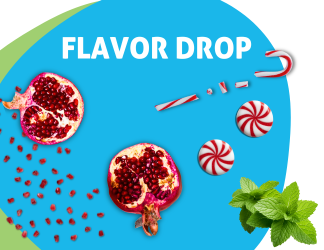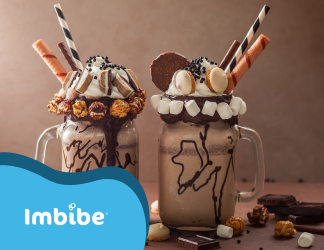Seasonal flavors have outgrown their role as fleeting novelties. Once a marketer’s playground, they’ve become a brand’s stealth R&D engine—a low-risk, high-reward laboratory for discovering what really moves consumers. Limited-time runs now function like open-source experiments, blending art, analytics, and emotion to find what sticks.
In 2025, flavor is less about “what’s trending” and more about emotional resonance—taste as memory, mood, and even identity. From nostalgic comforts to global mashups, consumers are chasing experiences that engage both the senses and the spirit.
Here’s how flavor is unfolding—season by season—and where the next wave of innovation is already taking shape.
Fall: Comfort Gets Restless
Every fall brings a craving for ritual—a mug, a blanket, a flavor that feels like home. Yet comfort doesn’t mean complacency. This season’s standouts—cranberry (Google search growth up 7% in the past year), chai (+8%), and molasses (+9%)—are stretching across categories.
Cranberry has evolved from side dish to year-round power note. Spindrift’s Cranberry Punch and Cranberry Raspberry (August 2025) capture its tart-bright appeal, while Chick-fil-A’s Cherry Berry (cherry, blueberry, cranberry) proves berry-forward blends win across demographics.
Pumpkin still anchors the season, but maple and apple continue to dominate menus, and pecan is the breakout—up 28% YoY on DoorDash. Expect spicy cranberry, apple chai, and apple crisp to bridge comfort and indulgence, while cookie butter builds momentum into winter. Creative mashups such as matcha maple add modern wellness cues to nostalgic formats.
Winter: Tradition Meets Botanical Resonance
Winter classics—gingerbread, peppermint, eggnog, sugar plum—still ground the season, but consumers now crave more dimension. The emerging current blends comfort with “quiet botanicals” that temper sweetness and add sophistication.
Polar Beverages’ Elderflower Starlight, Spiced Pear Cider, and PopSips recently launched Raspberry Rose illustrate this shift toward floral-fruit hybrids. Rose and elderflower in particular are gaining traction; Innova Market Insights links rose to luxury and mood elevation. Expect hibiscus, lavender, violet, and elderflower to keep influencing beverage and confection launches into 2026.
Next winter won’t replace the classics—it’ll reimagine them: peppermint kissed with rose, eggnog brightened by elderflower, or brown butter and cookie butter bridging late fall and deep winter. Cozy dark-sugar notes will anchor the mainstream, while avant-garde brands explore floral and herbal layers that add intrigue without losing nostalgia.
As winter’s indulgent warmth gives way to spring’s clarity, consumers aren’t seeking entirely new flavors—they’re looking for fresh interpretations of the familiar. The botanicals that once softened rich profiles now lift and brighten them, and fruits that grounded cold-weather comfort evolve into vehicles for renewal and sensory play. It’s less a seasonal reset and more a flavor awakening—one that keeps the emotional resonance of winter while introducing lightness, texture, and discovery.
Spring: Bright, Layered, and Sensory Satisfaction
Spring doesn’t abandon winter’s palette so much as it lightens and layers it. Many of the same botanicals—lavender, hibiscus, elderflower—carry over, but their roles evolve. The “quiet botanicals” of winter that tempered sweetness now become floral expressions of renewal, complemented by brighter fruits and lighter textures. Mint, for instance, shifts from a winter comfort accent to a spring refresher; lavender moves from cozy to uplifting.
Spring refreshment remains fruit-forward—strawberry, kiwi, and citrus still lead—but the real innovation lies in nuanced flavor builds and multisensory appeal. Starbucks’ Strawberry Matcha Strato Frappuccino (2025) reaffirmed strawberry’s seasonal staying power while signaling the rise of experiential layering: sweet meets earthy, vibrant meets creamy. Similarly, Topo Chico Hard Strawberry Hibiscus reflects how floral-fruit hybrids are crossing into mainstream appeal.
Emerging additions like rhubarb—with menu mentions up 23% over four years (Datassential) and interest up 70% year-over-year (Tastewise)—are introducing a tart counterpoint to balance fruit sweetness. KDP’s 2025 Beverage Report also highlights coconut, blueberry, and almond, suggesting a continued move toward familiar yet versatile comfort flavors that bridge winter’s indulgence with spring’s freshness.
Overall, Spring 2026 will favor fruit with depth—refreshing yet elevated. Expect beverages that trade sugar for sophistication, embracing natural sweetness, floral nuance, and sensory texture. It’s not about replacing winter’s botanicals—it’s about letting them bloom.
Summer: Bold, Bright, and Playfully Provocative
If fall comforts and winter indulges, summer explodes. The “swicy” (sweet-meets-spicy) movement has gone mainstream, driven by Gen Z and Millennials chasing sensory contrast and dopamine-rich excitement. Innova Market Insights names “swicy” one of 2025’s top global flavor breakthroughs—and the proof is everywhere.
7UP Endless Summer delivers layered citrus brightness with subtle spice cues. Siggi’s Spiced Pear & Fig brings gentle heat to dairy. Mango-habanero, pineapple-chili, and calamansi flavors are proliferating across frozen, RTD, and snack aisles. Even pickle is surging—KFC’s Pickle Pepsi and SONIC’s Picklerita Slush tapped the trend, with pickle-flavored drinks up 239% YoY (Tastewise).
Yet indulgence still sells. La Colombe’s S’mores Latte shows nostalgia and decadence thriving alongside bold innovation. The opportunity is in the and—spice and sweet, heat and creamy, adventure and memory, you and Imbibe. Brands that master this duality will define future year’s hits.
Let’s Co-Create Tomorrow’s Classics
The flavors defining 2025 are already writing 2026’s script. If your brand is ready to move beyond trend-spotting to trend-setting, Imbibe is ready to help translate flavor into growth. Connect to start writing the next great taste story, seasonal or timeless.



